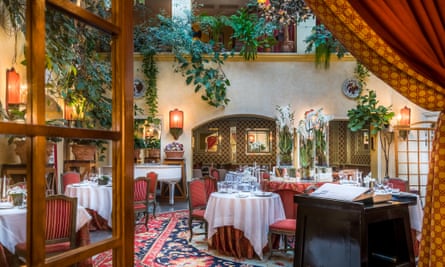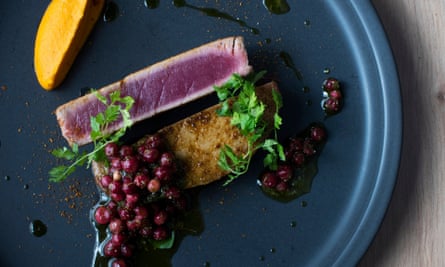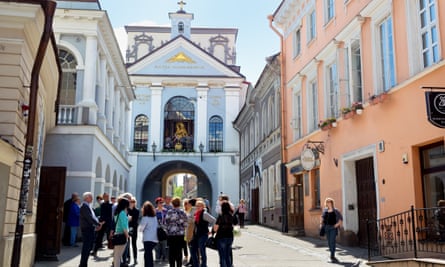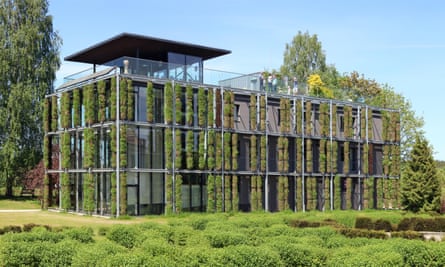The poster produced by two students referring to Lithuania’s capital as Europe’s G-spot really sums the city up: it is not where you thought it was. It is not in eastern Europe, not even in central Europe, but the capital of a Baltic state in northern Europe.
Founded in 1323 by grand duke Gediminas, who attracted Jewish and German tradesmen and merchants with generous tax exemptions, for centuries it became a destination for those fleeing religious persecution (there was even a Scottish Calvinist community in Vilnius) or tough trade guild regulations. The city’s coat of arms features Saint Christopher, the patron saint of travellers.
The same liberal attitude continued through the centuries, and today the city still has its Catholic, Protestant, Jewish and Ruthenian Orthodox quarters. For two centuries from 1569, it was the co-capital of what was then Europe’s biggest empire – the Polish-Lithuanian Commonwealth. Later, Vilnius withstood Russian tsarist and Soviet occupation, and in 1991 gained its freedom and independence.
Užupis Republic

On 1 April 1997, the Užupis district (the name means “over the river”) declared itself a separate republic, forming a bohemian commune with a president, foreign ministry and even a constitution. During Soviet times, Užupis Street was called the Lane of Death for its crime rate, but it’s safe now, and boasts galleries, boutiques and restaurants. On Thursdays, nearby Tymo Turgus food market is the destination for organic produce: stalls sell homemade cheeses and juniper smoked meats, honey (including linden, clover and forest flowers), pickles, jams and preserves (sea buckthorn and rosehip are local specialities), herbal teas, berries and vegetables. There’s also plenty of streetfood – artisanal burgers and bagels, meat on skewers and pastries – to enjoy to the sound of local DJs. Stop in at Špunka (Užupio g 9), a cosy pub with a wide selection of local beers.
10am-3.30pm, tymoturgelis.lt
National Gallery

Vilnians love the Nacionalinė Dailės Galerija, simply called NDG, across the River Neris from the centre. What was the Museum of Revolution has been revamped into a contemporary art gallery. The permanent exhibitions are contemporary and of 20th-century Lithuanian art (though you won’t see our symbolists – the best of them are currently are on loan to Paris’s Musée d’Orsay for its Wild Souls: Symbolism in the Baltic States show). The bookstore is fantastic, and the restaurant has a river view and a European menu that changes weekly.
Konstitucijos prospektas 22, ndg.lt
Stikliai Hotel

The Stikliai (Glassblowers) hotel was the first five-star hotel in Vilnius to open after independence in 1990. Yet it is relatively affordable, with rooms from €144. It’s in the former Jewish quarter, with easy access to all the main sights. There is a pool in the basement, a closed atrium with greenery and a comfortable conservatory which is a locals’ favourite place for a nightcap. Pastry shop “Ponių laimė” (Ladies’ Joy) across the street belongs to the same owners and all the fruits served in the hotel come from their eco-farm in Dubingiai, 50km north of the city. More affordable is the Amberton Hotel, which overlooks Cathedral Square and has doubles from €98 B&B.
stikliaihotel.lt
Restaurants

Most good restaurants in the city are determined to use only locally sourced organic produce, taking inspiration from the seasons and adding a contemporary twist to traditional Lithuanian recipes. Publication of the annual list of Lithuania’s 30 best restaurants is hotly anticipated. Most restaurants in the top 30 are reasonable, with mains from €20. Try the local fish – pike, sturgeon and smoked eel – at places like Dine; and mushrooms at restaurants such as Gaspar’s or Somm (try anything with boletus). Beetroot is in vogue – from crisps to tartares to ice-creams – and is popular on the menu at Dziaugsmas.
Gate of Dawn

The chapel in the Gate of Dawn in the former city wall hosts our famous Madonna, in radiant gold and silver. Painted by an unknown artist, it was placed over the gates in the 16th century to protect the city from enemies and is said to have miraculous powers. There are copies in Saint Peter’s in Rome, in Paris, Venice and South America. Fortunately, a Soviet plan to demolish the gates in the 1950s to make way for the avenue leading to the station was abandoned. Locals go there to pray, and they continue the tradition of bringing ex votos – silver and gilt hearts, arms and legs, representing body parts that were healed. The walls of the shrine are covered with thousands of them.
Aušros Vartų 14, ausrosvartai.lt
St John’s Church

For an overview of the extensive Unesco-listed old town, take the lift (open May-October) up the belltower of St John’s Church and climb the last few steps to the open balcony. There, 60 metres up, you’ll notice German gothic, Italian baroque and French classicist architecture, plus Russian Orthodox domes and the labyrinth of the Jewish quarter, all surrounded by green hills. Several scenes of the BBC’s 2016 adaption of War & Peace were shot within this view.
University Street, muziejus.vu.lt
Church of St Peter & Paul

Aristocratic 18th-century Lithuanian travellers were rather unimpressed with London’s St Paul’s Cathedral and noted in their diaries that its interior did not come close to St Peter and Paul’s church in Vilnius. Begun in 1668 it embodies the baroque principle – a balance between control and chaos. There are thousands of sculptures by Giovanni Pietro Perti and his team from Ticino, Switzerland, all in white stucco. Look for the statue of Saint Mary Magdalene in a fashionable dress – it’s said to be a portrait of Perti’s beloved Lithuanian wife, Magdalena.
Antakalnio 1, vilniauspetropovilo.lt
Museum of Occupations and Freedom Fights

At this sobering must-see, visitors can go into the cells, where, between 1958 and 1987, thousands of Lithuanians were detained, interrogated, tortured and executed. Once a courthouse, it became the Gestapo’s Vilnius HQ after the Nazi invasion, and would have played a role in the murder of much of the country’s Jewish population, before the KGB moved in after the USSR retook the Baltic states during 1944. After that, many who entered this building emerged only to be deported to the gulags of Siberia. You will come out enlightened about the reality of the Soviet socialist system. It is one of the best-rated museums by foreign visitors and essential to understanding the recent history of Lithuania.
Aukų 2A, genocid.lt/muziejus
Vilnius City Opera
Vilnius is known for its classical musicians and singers – Jascha Heifetz was born and discovered as a prodigy here. The famous mezzosoprano Violeta Urmana is more often on the stage of Milan’s La Scala than at home, but do check the programmes. Directed by a Dalia Ibelhauptaite (wife of British actor and director Dexter Fletcher), the productions are young, ambitious and spectacular , from a half-British team, working with the best of Lithuanian vocal talents, usually heard in Glyndebourne, Covent Garden or Salzburg. Best of all, tickets start from €20.
Congress Palace, Vilniaus 6, on Facebook
Botanical garden

Vilnius University is home to a venerable botanical garden, founded in 1781 by French professor Jean-Emmanuel Gilibert and later expanded by James Cook’s companion, the botanist Georg Forster. Since 1974 it has been at Kairėnai, on the outskirts of Vilnius, in the woods of a former country manor. May sees an amazing variety of lilacs in bloom, the rhododendron collection is impressive in June, and there are also Japanese gardens. There’s also horse riding – €10-€15 for an hour’s ride, carriage rides from €30 and a barbecue area with picnic tables.
Entry €1.5o, botanikos-sodas.vu.lt
Getting there
Norwegian and airBaltic fly to Vilnius from Gatwick, Wizz Air flies from Belfast, Doncaster/Sheffield and Luton, and Ryanair from six UK airports.
Best time to go
2018 is the centenary of the restored state of Lithuania, which will be celebrated at the Centenary Song Festival (30 June-6 July), with a focus on traditional music, crafts and folklore, culminating in a choir of 20,000 singers and 6,000 dancers performing at Vingis Park. The Christopher Summer Festival (12 July-28 August) features classical, jazz and pop.
Exchange rate
£1 = €1.13
Beer in a pub: around €3.25 for half litre

Comments (…)
Sign in or create your Guardian account to join the discussion